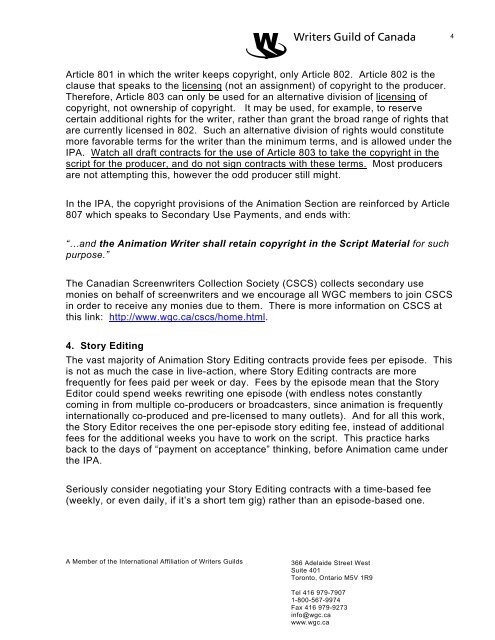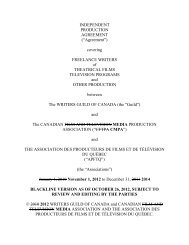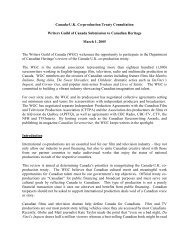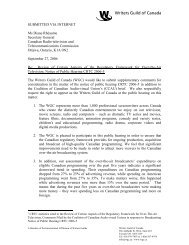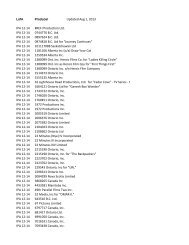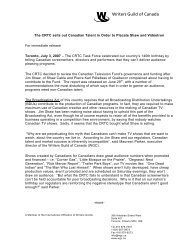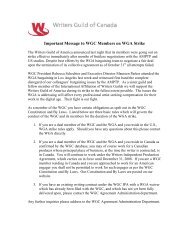Animation Contract Guidelines Introduction Now that the 2006-2008 ...
Animation Contract Guidelines Introduction Now that the 2006-2008 ...
Animation Contract Guidelines Introduction Now that the 2006-2008 ...
You also want an ePaper? Increase the reach of your titles
YUMPU automatically turns print PDFs into web optimized ePapers that Google loves.
4Article 801 in which <strong>the</strong> writer keeps copyright, only Article 802. Article 802 is <strong>the</strong>clause <strong>that</strong> speaks to <strong>the</strong> licensing (not an assignment) of copyright to <strong>the</strong> producer.Therefore, Article 803 can only be used for an alternative division of licensing ofcopyright, not ownership of copyright. It may be used, for example, to reservecertain additional rights for <strong>the</strong> writer, ra<strong>the</strong>r than grant <strong>the</strong> broad range of rights <strong>that</strong>are currently licensed in 802. Such an alternative division of rights would constitutemore favorable terms for <strong>the</strong> writer than <strong>the</strong> minimum terms, and is allowed under <strong>the</strong>IPA. Watch all draft contracts for <strong>the</strong> use of Article 803 to take <strong>the</strong> copyright in <strong>the</strong>script for <strong>the</strong> producer, and do not sign contracts with <strong>the</strong>se terms. Most producersare not attempting this, however <strong>the</strong> odd producer still might.In <strong>the</strong> IPA, <strong>the</strong> copyright provisions of <strong>the</strong> <strong>Animation</strong> Section are reinforced by Article807 which speaks to Secondary Use Payments, and ends with:“…and <strong>the</strong> <strong>Animation</strong> Writer shall retain copyright in <strong>the</strong> Script Material for suchpurpose.”The Canadian Screenwriters Collection Society (CSCS) collects secondary usemonies on behalf of screenwriters and we encourage all WGC members to join CSCSin order to receive any monies due to <strong>the</strong>m. There is more information on CSCS atthis link: http://www.wgc.ca/cscs/home.html.4. Story EditingThe vast majority of <strong>Animation</strong> Story Editing contracts provide fees per episode. Thisis not as much <strong>the</strong> case in live-action, where Story Editing contracts are morefrequently for fees paid per week or day. Fees by <strong>the</strong> episode mean <strong>that</strong> <strong>the</strong> StoryEditor could spend weeks rewriting one episode (with endless notes constantlycoming in from multiple co-producers or broadcasters, since animation is frequentlyinternationally co-produced and pre-licensed to many outlets). And for all this work,<strong>the</strong> Story Editor receives <strong>the</strong> one per-episode story editing fee, instead of additionalfees for <strong>the</strong> additional weeks you have to work on <strong>the</strong> script. This practice harksback to <strong>the</strong> days of “payment on acceptance” thinking, before <strong>Animation</strong> came under<strong>the</strong> IPA.Seriously consider negotiating your Story Editing contracts with a time-based fee(weekly, or even daily, if it’s a short tem gig) ra<strong>the</strong>r than an episode-based one.A Member of <strong>the</strong> International Affiliation of Writers Guilds366 Adelaide Street WestSuite 401Toronto, Ontario M5V 1R9Tel 416 979-79071-800-567-9974Fax 416 979-9273info@wgc.cawww.wgc.ca


